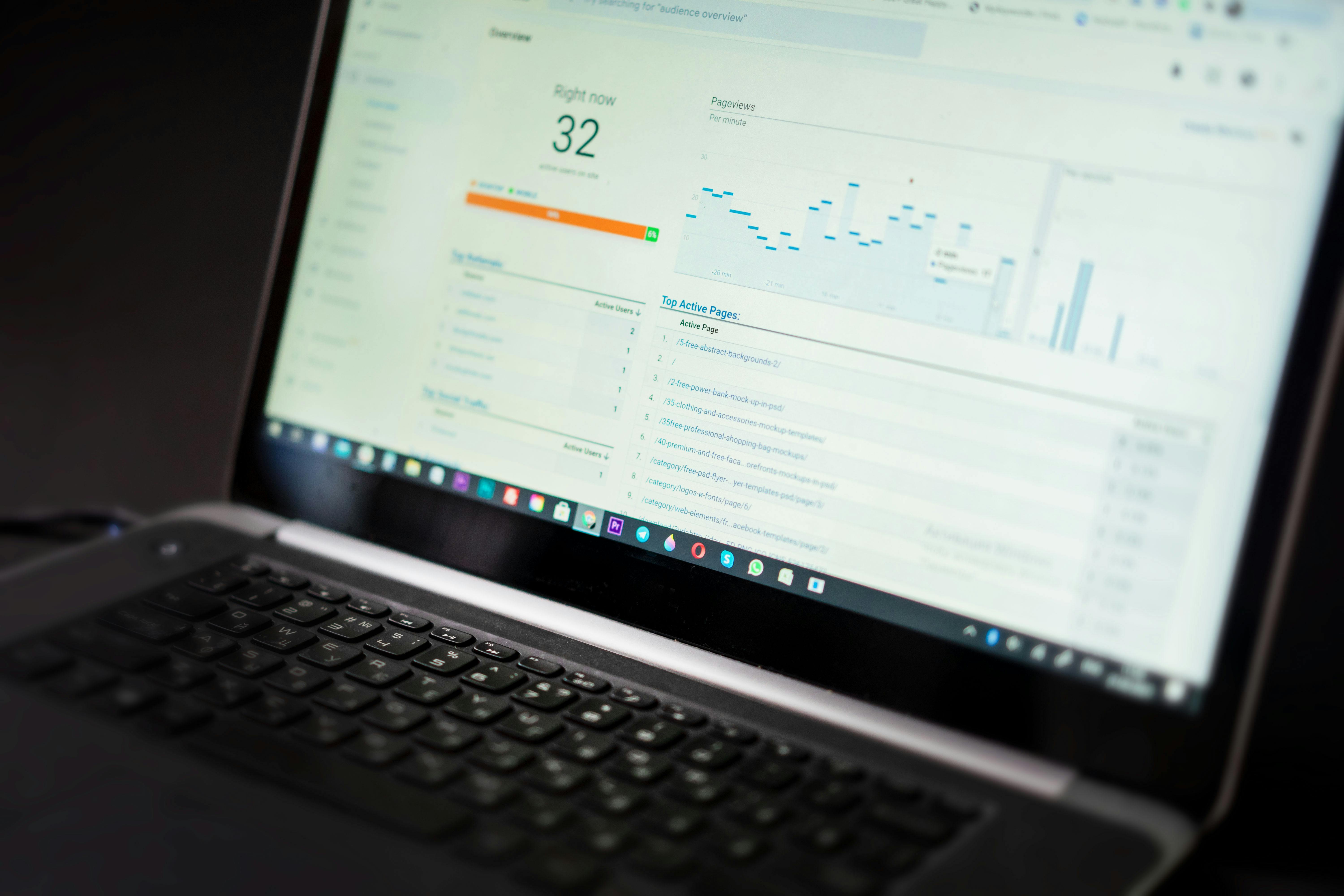In the ever-evolving world of SEO, backlink management dashboards have emerged as essential tools for digital marketers and website owners. But what exactly should you be tracking to ensure your link-building efforts are effective? This article explores the key metrics that can elevate your backlink strategy, helping you understand which links are driving traffic and enhancing your website’s authority. Tracking backlinks is not just about quantity; it’s also about quality, and knowing how to interpret these metrics can be the difference between a thriving online presence and a neglected one.
When it comes to backlink analysis, the first metric to consider is the authority score of your backlinks. This score indicates the trustworthiness and credibility of the referring domains. But, wait! Are you also keeping an eye on the anchor text used in your backlinks? This can significantly impact your SEO performance. Additionally, monitoring the referring domains is crucial. Are you gaining links from high-authority websites, or are you stuck with low-quality sources? Understanding these factors is vital for building a robust backlink profile.
Another critical aspect of backlink management is tracking lost backlinks. Have you noticed a drop in your rankings? It might be because you’ve lost valuable links. By keeping tabs on which backlinks are disappearing and why, you can take proactive measures to recover them or find new opportunities. Ultimately, the right backlink metrics can provide you with actionable insights that boost your website’s visibility and ranking. So, are you ready to dive into the world of backlink management dashboards and discover how to track these essential metrics effectively? Let’s explore together!
Top 7 Essential Metrics for Backlink Management Dashboards: Are You Tracking These Key Indicators?

In the ever-changing world of digital marketing, keeping track of your backlinks is crucial for achieving SEO success. Backlink management dashboards have become essential tools for marketers, allowing them to monitor and analyze their backlink profiles. But what metrics should you focus on? Many people often overlook the specifics. Here’s a look at the top 7 essential metrics for backlink management dashboards that you absolutely should track.
1. Total Backlinks
Understanding the total number of backlinks pointing to your website is the starting point. This metric give you a clear picture of your website’s authority. However, not all backlinks are created equal; the quality of these links often matters more than quantity. If you have hundreds of links but they’re from low-quality sites, you might not see the results you expect.
2. Referring Domains
Referring domains are unique domains that link back to your site. This metric is vital to track because having a large number of referring domains usually indicates that your site is viewed as a valuable resource. It’s better to have a smaller number of high-quality domains linking to you than a large number of low-quality ones. Just to illustrate, if you have 50 backlinks but they come from only 5 domains, that’s not as impressive as having 50 backlinks from 50 different domains.
3. Domain Authority
Domain Authority (DA) is a score developed by Moz that predicts how well a website will rank on search engines. The score ranges from 1 to 100, with higher scores indicating a greater ability to rank. Tracking the DA of your referring domains can help you understand the potential impact of those backlinks on your own site’s SEO. If you’re getting backlinks from domains with high DA, that’s generally a good sign.
4. Anchor Text Distribution
The anchor text of a backlink is the clickable text that users see. This metric is often overlooked, but it’s important to track because it can affect your SEO. Ideally, your anchor text should be a mix of branded, generic, and exact match keywords. If all your backlinks use the same anchor text, it could raise a red flag for search engines, making it look like you’re trying to manipulate rankings.
5. Link Type
Backlinks can be categorized into two types: dofollow and nofollow. Dofollow links contribute to your site’s SEO by passing on link equity, while nofollow links don’t. It’s important to track the ratio of dofollow to nofollow links. A healthy backlink profile typically contains a mix of both, so tracking this metric can help you understand the overall health of your backlink strategy.
6. Link Velocity
Link velocity refers to the speed at which you acquire backlinks over time. Tracking this metric helps you understand if your backlink strategy is sustainable. If you suddenly gain a lot of links in a short period, it may look suspicious to search engines, which could lead to penalties. Therefore, gradual growth is often preferred and results in a more natural backlink profile.
7. Lost Backlinks
This metric provides insight into how many backlinks you’ve lost over a specific period. Regularly tracking lost backlinks can help you identify potential issues with your website or content that may have led to these losses. If you notice a spike in lost backlinks, it might be worth investigating why that happened. For example, maybe a referring domain has gone offline or changed its linking policy.
Practical Examples of Tracking
Setting up your backlink management dashboard can seem daunting, but it doesn’t have to be. You can use tools like Ahrefs, Moz, or SEMrush to track these metrics easily. These platforms allow you to visualize your backlink profile and see trends over time.
- Example: If you notice that your total backlinks have decreased while your referring domains remain stable, it could suggest that you’re losing links from certain domains.
- Another Example: If your anchor text distribution shows an over-reliance on one keyword, you might need to diversify your backlink strategy.
To summarize, monitoring these key metrics can make a big difference in your SEO efforts. By focusing on total backlinks, referring domains, domain authority, anchor text distribution, link types, link velocity, and lost backlinks, you can develop a comprehensive understanding of your backlink strategy.
Keeping track of these indicators is not just for the sake of tracking itself. It’s about leveraging data to make informed decisions that can improve your website’s visibility and authority. In the competitive New York digital marketing landscape, these insights could be the edge you need to stay ahead.
The Ultimate Guide to Backlink Health: 5 Critical Metrics Every Dashboard Should Include

In the ever-evolving realm of digital marketing, understanding the health of your backlinks is crucial. Backlinks serve as a vote of confidence from one site to another, influencing your authority and SEO rankings. However, not all backlinks are created equal. If you want to keep a healthy backlink profile, you really need to track certain metrics. Here’s your ultimate guide to backlink health, highlighting five critical metrics every dashboard should include.
The Importance of Backlink Management Dashboards
Backlink management dashboards are like command centers for your SEO efforts. They allow you to visualize and track your backlink profile’s effectiveness and identify areas for improvement. A good dashboard should be able to show you a range of metrics that help you understand the quality and quantity of your backlinks.
Here are some key reasons why these dashboards are so valuable:
- Monitoring Progress: See how your backlink profile changes over time, helps identify trends.
- Spotting Toxic Links: Quickly find harmful backlinks that could negatively impact your site’s rankings.
- Strategic Planning: Helps you decide where to put your efforts in link-building campaigns.
5 Critical Metrics Every Dashboard Should Include
When it comes to tracking backlinks, there are certain metrics that are fundamental. Here’s a rundown of the five critical metrics your dashboard should show:
Domain Authority (DA):
- DA is a score developed by Moz that predicts how well a website will rank on search engine result pages (SERPs). The higher the DA, the more authoritative the site is.
- Tracking the DA of your backlinks can help you find influential sites.
Referring Domains:
- This metric shows how many unique domains are linking to your site. Not just the sheer number of backlinks, but the variety of domains matters.
- A diverse set of referring domains indicates a healthy backlink profile.
Anchor Text Distribution:
- The anchor text is the clickable text in a hyperlink. Monitoring anchor text helps you see if your backlinks are using varied and relevant terms.
- Over-optimized anchor texts can lead to penalties from search engines.
Link Type:
- Links can be categorized as dofollow or nofollow. Dofollow links pass authority, while nofollow links do not.
- Tracking the ratio of dofollow to nofollow links can help you understand the quality of your backlink profile.
Link Velocity:
- Link velocity refers to the speed at which your website acquires backlinks over time.
- A sudden spike can indicate a successful campaign, but an unexpected drop could flag potential issues.
What to Track in Your Backlink Management Dashboard
Every successful SEO professional knows that the devil is in the details. It’s not just about having a dashboard; it’s about knowing what to track. Here are some additional metrics that are valuable to consider:
- Link Status: Are your backlinks active or have they been removed? Keeping track of link statuses helps you know which links are still benefiting you.
- Spam Score: This is a metric from Moz that assesses the likelihood of a domain being penalized for spammy practices. High spam scores can indicate risky backlinks.
- Traffic from Backlinks: Monitor how much traffic each backlink is driving to your site. This can help you prioritize high-performing links in your strategy.
Practical Examples of Backlink Management
For instance, if you notice a high number of backlinks from low DA sites, it might be time to rethink your link-building strategies. Conversely, if you consistently see traffic coming from a few high DA sites, you might want to reach out for more partnerships.
You might also consider creating a table to compare your metrics over time. Here’s a simple way to outline it:
| Metric | Initial Value | Current Value | Change |
|---|---|---|---|
| Domain Authority | 20 | 30 | +10 |
| Referring Domains | 50 | 100 | +50 |
| Dofollow Links | 40 | 70 | +30 |
| Nofollow Links | 10 | 30 | +20 |
| Spam Score | 5% | 3% | -2% |
Using such a table makes it easier to visualize your progress over time.
In conclusion, managing your backlinks is not just a task; it’s a crucial element of your SEO strategy that demands attention. By focusing on these five critical metrics, along with other relevant data, you can create a robust backlink management dashboard that not only measures your current standing but also guides you towards greater online visibility. Remember, a healthy backlink profile is a key component of successful SEO in New York and beyond!
Unlocking SEO Success: What 10 Backlink Metrics Can Transform Your Strategy?

In the fast-paced world of digital marketing, understanding SEO is crucial for any business aiming to establish a strong online presence. One key area that often gets overlooked is backlink management, which can be a game-changer for your SEO strategy. If you wanna unlock SEO success, knowing what metrics to track in your backlink management dashboards can make a big difference. Here, we will delve into ten essential backlink metrics that can help you transform your strategy.
The Importance of Backlinks
Backlinks are like votes of confidence from other websites. When a reputable site links to your content, it signals to search engines that your site is valuable and trustworthy. The more quality backlinks you have, the higher you rank in search results. However, not all backlinks are created equal, and that’s where metrics come into play.
Key Backlink Metrics to Track
Domain Authority (DA): This metric, developed by Moz, measures the strength of a domain based on various factors. A higher DA means your backlinks come from more authoritative sources, which can improve your own site’s ranking.
Page Authority (PA): Similar to DA, PA measures the strength of a specific page rather than the entire domain. Tracking this can help you identify which of your pages are performing well.
Referring Domains: This metric shows the number of unique domains linking to your site. Having a diverse range of referring domains can enhance your credibility and can boost your ranking.
Backlink Quality: Not all backlinks are beneficial. Quality backlinks come from relevant, high-authority sites. It’s important to assess the quality of each backlink rather than just the quantity.
Anchor Text Distribution: The text used in the hyperlink is crucial for SEO. It should be relevant to the content it’s linking to. Monitoring your anchor text can help you avoid issues like over-optimization.
Follow vs. Nofollow Links: Follow links pass on SEO authority while nofollow links do not. It’s important to track the ratio of these links to ensure a healthy backlink profile.
Link Growth Rate: Keeping an eye on how quickly your backlinks are growing can help you gauge the effectiveness of your content marketing strategy. A steady increase is usually a good sign.
Lost Backlinks: Regularly checking for lost backlinks can help you understand if your content is still being valued by others. If you notice a drop, it could signal a problem that needs addressing.
Social Signals: Links that come from social media can drive traffic and engagement, although they may not directly impact SEO. Tracking these can give you insight into your content’s reach.
Spam Score: It’s important to monitor the spam score of your backlinks to avoid any penalties from search engines. High spam scores can indicate low-quality backlinks that could harm your site’s reputation.
Backlink Management Dashboards: What to Track
When it comes to managing backlinks, having a well-structured dashboard can simplify the process. Here’s a list of key metrics you should track on your backlink management dashboard:
- Total Backlinks: The overall number of backlinks pointing to your site.
- New vs. Lost Backlinks: A comparison of new links gained versus those lost over a specific period.
- Top Referring Domains: A list of the most valuable domains that link to your site.
- Backlink Types: Categorizing your backlinks into follow, nofollow, and sponsored links for better analysis.
- Traffic from Backlinks: Measuring the amount of traffic generated from your backlinks can show you their effectiveness.
Practical Examples of Backlink Management
To put these metrics into perspective, let’s consider a hypothetical business, “EcoHome,” that specializes in eco-friendly products. Initially, EcoHome had a DA of 25 with 50 backlinks. By focusing on high-quality content and outreach, they increased their DA to 40 with 200 backlinks over a year. By tracking their referring domains, they discovered that collaborations with bloggers in the eco-friendly niche led to a significant increase in traffic.
Final Thoughts
Backlink metrics are essential for any SEO strategy, especially for businesses in competitive markets like New York. By utilizing a comprehensive backlink management dashboard and focusing on the right metrics, you can make informed decisions that enhance your online visibility. The road to SEO success is paved with quality backlinks, and with the right tools and approaches, you can navigate this journey effectively. Remember, SEO is not just about generating traffic; it’s about attracting the right audience to your brand.
How to Measure Backlink Quality: 6 Key Metrics You Can’t Afford to Ignore!

In the ever-evolving world of digital marketing, backlinks remains a crucial element for SEO success. However, not all backlinks are created equal. Understanding how to measure backlink quality is vital for any marketer, especially in a competitive market like New York. So, let’s delve into the key metrics you can’t afford to ignore while managing your backlinks.
Understanding Backlink Quality
Backlink quality is determined by several factors that influences how search engines perceive your website. Just because a site links to you doesn’t mean it’s beneficial. In fact, low-quality backlinks can harm your rankings. So, to ensure you’re on the right track, consider tracking the following metrics.
1. Domain Authority (DA)
Domain Authority is a metric developed by Moz that predicts how well a website will rank on search engine result pages (SERPs). It’s on a scale from 1 to 100, with higher scores indicating a better ability to rank. When evaluating potential backlinks, aim for sites with a higher DA. If a website has a DA of 50 and you get a backlink from it, it’s more likely to improve your own DA over time.
2. Page Authority (PA)
Similar to Domain Authority, Page Authority measures the ranking potential of a specific page rather than the whole site. It also ranges from 1 to 100. If you’re looking at a potential backlink from a page with a PA of 60, it could bring significant value to your link profile. Like DA, the higher the PA, the better the link quality.
3. Relevance of the Linking Site
Not all backlinks are equally relevant. A link from a site that is closely related to your industry is more valuable than one from an unrelated niche. For example, if you run a vegan restaurant in New York, a backlink from a health-focused blog will carry more weight than a link from a car dealership. Make sure to evaluate how relevant the linking site is to your content.
4. Trust Flow and Citation Flow
Developed by Majestic, Trust Flow measures the quality of links pointing to a site, while Citation Flow measures the quantity of backlinks. A good balance between these two metrics is crucial. If a site has high Citation Flow but low Trust Flow, it may indicate that the site is spammy. You want a healthy ratio, usually aiming for higher Trust Flow than Citation Flow.
5. Anchor Text Diversity
The anchor text used in backlinks is also an important metric. It provides context to search engines about the content of the linked page. If a site uses diverse and relevant anchor texts when linking to you, it indicates a more natural link profile. However, over-optimization with exact-match keywords can lead to penalties, so a mix is necessary.
6. Follow vs. Nofollow Links
Understanding the difference between follow and nofollow links is crucial. Follow links pass on link equity (ranking power), while nofollow links do not. However, nofollow links still hold value as they can drive traffic and increase brand awareness. Monitor the ratio of follow to nofollow links in your backlink profile to maintain a healthy balance.
Backlink Management Dashboards: What to Track
So, how do you keep track of all these metrics? A backlink management dashboard can be an invaluable tool for marketers. Here are some critical elements to include in your dashboard.
- Total Backlinks: Keep a count of how many backlinks you have.
- Referring Domains: Track the number of unique domains linking to your site.
- Backlink Quality Score: Use tools that provide a quality score for backlinks.
- New vs. Lost Backlinks: Monitor new backlinks gained versus those lost.
- Link Velocity: Understand how quickly you’re gaining or losing links.
- Spam Score: Evaluate the spam score of linking domains to avoid harmful links.
Practical Example of Metrics in Action
Let’s say you’re analyzing a backlink from a popular food blog in New York. The blog has a DA of 75, a PA of 65, and uses a variety of anchor texts like “best vegan restaurant” and “healthy dining.” The Trust Flow is 40, and the Citation Flow is 50. This indicates a strong, relevant, and trustworthy link that would likely benefit your site.
On the other hand, if you find a backlink from a site with a DA of 20, low relevance, and a high spam score, it may be wise to disavow that link to protect your site’s authority.
In the fast-paced realm of digital marketing, understanding how to measure backlink quality and effectively manage your backlink profile can set you apart from competitors. By focusing on these essential metrics, you can ensure that your SEO efforts are not just effective but also sustainable. Quality over quantity is the mantra you should live by when it comes to backlinks. Investing time in tracking these metrics will pay
Backlink Management Dashboard Insights: What Are the 5 Game-Changing Metrics You Should Monitor?

In the fast-paced world of digital marketing, backlink management dashboards have become essential tools for SEO professionals. If you’re in New York and looking to elevate your online presence, understanding the metrics provided by these dashboards is crucial. Backlinks are basically the votes of confidence from other websites that help improve your site’s authority and ranking. But managing them can be tricky. So, what are the five game-changing metrics that you should monitor? Let’s dive into it.
1. Total Backlinks
First up, total backlinks. This metric gives you a snapshot of how many links are pointing to your website. It’s like counting the number of friends you got on social media; more often means more popularity. However, not all backlinks are created equal. For example, a link from a high-authority site like The New York Times is way more valuable than one from a low-quality blog.
- Why it matters: Higher numbers usually indicate credibility, but always evaluate the quality.
- How to track: Most backlink management dashboards will show this number prominently.
2. Referring Domains
Next, we got referring domains. This metric tracks how many unique domains are linking to your site. Tracking this is crucial because a diverse backlink profile is typically more beneficial. Imagine if all your friends came from the same neighborhood—it’s not very diverse.
- Quality over quantity: A few high-quality links from diverse sources often outperform many low-quality links from similar sources.
- Monitoring tools: Use tools like Ahrefs or SEMrush to see your referring domains.
3. Anchor Text Distribution
Anchor text is the clickable text in a hyperlink. It’s important to monitor the anchor text distribution because it helps search engines understand what your content is about. If all your backlinks use the same anchor text, it might look suspicious to Google, like you’re trying to game the system.
- Variety is key: Using a mix of branded, exact match, and generic anchor texts helps create a natural backlink profile.
- Tools for analysis: Most dashboards will display anchor text distributions, allowing you to see if you’re balanced or over-optimized.
4. Domain Authority (DA)
Domain Authority is a score developed by Moz that predicts how well a website will rank on search engine results pages (SERPs). While it’s not a direct ranking factor, monitoring your DA is still valuable. It reflects the overall strength of your domain compared to others.
- How it’s calculated: DA is based on various factors, including the number and quality of backlinks.
- Comparison: Tracking your DA over time lets you see how your efforts in backlink management are paying off.
5. Toxic Backlinks
Lastly, let’s talk about toxic backlinks. These are links from low-quality or spammy sites that can harm your SEO. Monitoring toxic backlinks is essential because they can lead to penalties from search engines.
- Identifying toxicity: Most backlink management tools can identify potentially harmful links based on various factors, like domain authority and relevance.
- What to do: If you find toxic backlinks, you can disavow them through Google Search Console to help maintain your site’s health.
In summary, managing backlinks is not just about quantity; it’s about quality, diversity, and relevance. By keeping an eye on these five key metrics, you can make informed decisions that will enhance your SEO efforts in New York or wherever you are. Utilizing a robust backlink management dashboard can provide you with these insights and much more, enabling you to refine your strategy and boost your online visibility.
Backlink management is like maintaining a garden. You need to regularly check what’s growing, remove the weeds, and nurture the healthy plants. The same goes for your backlinks—keep what works and eliminate what doesn’t. Embrace these metrics, and you’ll be well on your way to mastering the art of backlink management.
Conclusion
In conclusion, effective backlink management is crucial for enhancing your website’s SEO performance, and utilizing a comprehensive dashboard can streamline this process. Throughout this article, we discussed the essential metrics to track, including the quality and relevance of backlinks, anchor text diversity, domain authority, and the overall impact on organic traffic. By monitoring these key indicators, you can identify valuable linking opportunities, assess the health of your backlink profile, and make informed decisions to improve your search engine rankings. Remember, a well-structured backlink management strategy not only boosts visibility but also establishes your credibility in your niche. Take the initiative to implement a robust backlink management dashboard today, and stay ahead of your competition by leveraging data-driven insights to build a stronger online presence. Start tracking, analyzing, and optimizing your backlinks for sustained success in the digital landscape.








